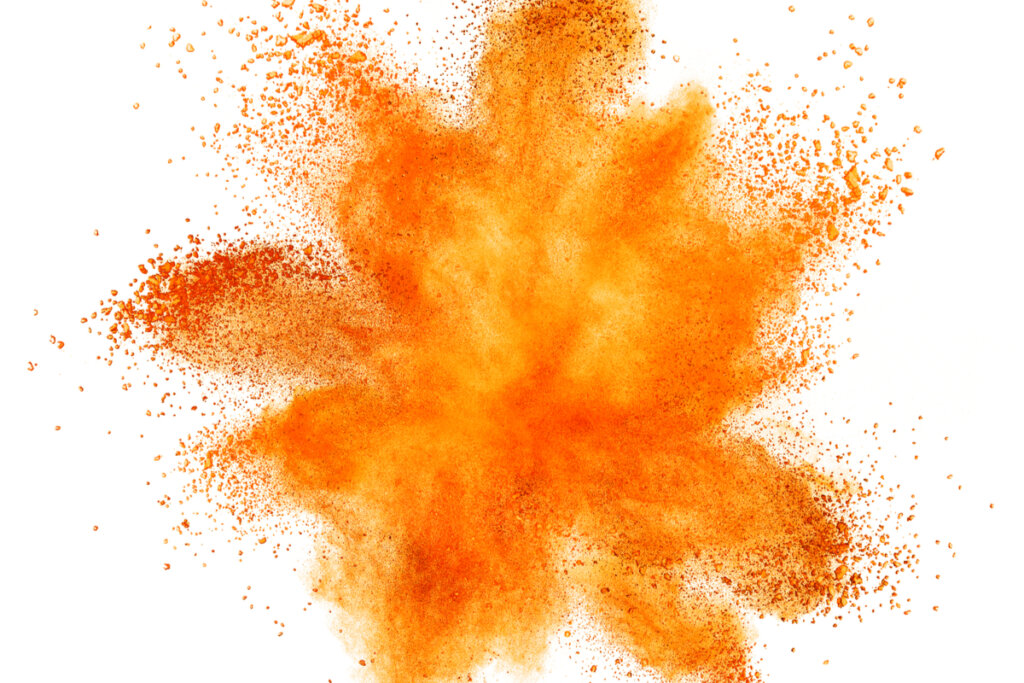What Does the Color Orange Mean in Psychology?

Humans have studied color for a long time. It’s an interesting subject, as people’s relationship with the environment, and the development of culture and interpersonal relationships influence the emotions and attitudes that each color elicits. The meaning of the color orange is broad. It depends a great deal on associated variables, such as intensity. Its meanings can range from creativity to destruction.
In this article, you’ll be able to explore the physical characteristics and connotations of each shade of orange. In fact, this color has been studied by some of the most representative figures of this school of psychology, such as Eva Heller.
The physics of the color orange
Orange is so-called due to its resemblance to the fruit of the orange tree. It’s perceived by photoreception of a light whose dominant wavelength measures 595-630 nanometers. Orange is considered a warm color. Lengths that are above 615 nanometers approach yellow. On the other hand, those approaching 595 nanometers are closer to red.
According to the law of light mixing (RGB system), orange is obtained by superimposing red light and green light, the latter at half the intensity of red. The complement of orange would be blue or cerulean. However, when it comes to pigments, orange is obtained from the mixture of red and yellow. This makes it a secondary color. This theory (CMYK system) is the most widely used in art, ink creation, and image reproduction in general.

The meaning of the color orange
As a rule, the meaning of the color orange revolves around playfulness, enthusiasm, and extroversion. It’s a striking and exotic color in certain regions (it’s not very evident in the natural environment), and some people consider it too intense.
Orange is also related to sociable, original, active, and enthusiastic people. On the less desirable side, it evokes feelings of rejection. For example, it tends to draw too much attention and can convey a sense of frivolity.
A more intense hue of orange is related to danger in some regions. This is especially the case in those areas where the population comes into contact with poisonous plants and animals. Indeed, in nature, bright colors are often a warning to predators. This is known as aposematic coloration.
Use of orange in marketing
Research claims that, in the promotion of certain products, colors exert a significant influence on decision-making and evoke specific feelings. Therefore, the psychology of color is one of the most important pillars of marketing.
Orange is associated with optimism. For this reason, it’s often chosen in marketing to incite purchases on a large scale.
With regard to orange -and the rest of the warm colors- it’s been proven that they help stimulate the appetite. That’s why they’re commonly used in restaurants and food brands. A relationship has also been found between deep orange and a sweet taste.
Using orange to attract attention
Orange is the color that’s most easily seen in low light conditions or in water. Therefore, it’s extremely useful for rescue and warning objects. For example, reflective and inflatable vests, as well as lifeboats.
In some places, prisoners’ uniforms are orange to make it easier to find them if they escape. This same principle is used in astronaut suits. It makes them more visible in the darkness of space. Another striking example is the famous airplane black box. Indeed, in reality, it’s orange so that it can easily be found.

The color orange in other cultures
What you’ve read so far relates to the meaning of the color orange in most western cultures. However, if you travel to other parts of the globe, you may find different meanings of this color. For example:
- Buddhism. Orange is the color of illumination, hence the costumes of Buddhist monks. These are in a shade close to the color of saffron.
- Hinduism. Orange is a color associated with the path to perfection. The divinity Krishna is represented in yellow and orange robes.
- Confucianism. In ancient Chinese philosophy, orange is the color of transformation.
- The Middle East. In certain countries in this part of the globe, such as Egypt, orange is associated with mourning and loss.
As you can see, the meaning of the color orange is varied and it has varying uses. Each of its tones evokes different feelings, both subjective and scientifically proven.
If you’re interested in this topic, we recommend you continue investigating it. Indeed, the mixture of the projective and the scientific is exciting when it comes to the psychology of color.
All cited sources were thoroughly reviewed by our team to ensure their quality, reliability, currency, and validity. The bibliography of this article was considered reliable and of academic or scientific accuracy.
- Álvarez, O. (2011). Influencia del color en las preferencias de los consumidores. Revista Observatorio Calasanz, 2(4): 228-246.
- Heller, E. (2004). Psicología del color. Cómo actúan los colores sobre los sentimientos y la razón. Editorial Gustavo Gili:
- Romero, JV. y Serrano, ML. (1968). ¿Influyen los colores en el sabor? Interamerican journal of psychology, 2(3): 144-157.
- Valdez, P. y Mehrabian, A. (1994). Effects of color on emotions. Journal of Experimental Psychology: General, 123(4): 394-409.
This text is provided for informational purposes only and does not replace consultation with a professional. If in doubt, consult your specialist.








